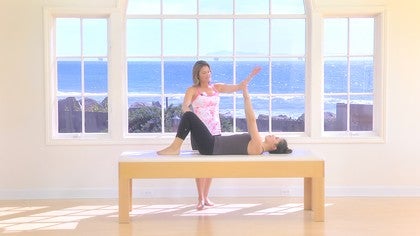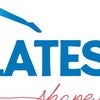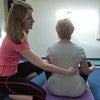Description
About This Video
Transcript
Read Full Transcript
Hey everyone, it's Amy and I have a short little tutorial that I want to give us today. And this is really maybe more of a discussion and experiment on, uh, the difference between an active hamstring stretch and a passive one. And I don't think one is better or, uh, than the other one. But active is more active and passive is just as sometimes just not as much of as sensation or change of a length of the muscle and the strength of it. Okay. And some of us in classes here and I'm sure you've been seeing in, in many of our classes are using more of the active stretch concept and um, it's working I think to change tissue and change muscle length and joint mobility and things like that. And so we'll show you an example you have, you don't need any prop for this, you'll just need the floor or your mat and then where you might be able to take it into an exercise in a mat class.
So let's just go ahead and roll onto her back. Okay. And I think what I'll have us do is just take one leg down to the mat just all the way down and then bring the other leg in and is hold behind your leg. Okay. And do good fundamentals with your shoulders and level pelvis and things like that. But we really are talking about the hamstrings, the back of the thigh. And what I want us to do is if you can straighten your knee all the way and let's just reach up as high as you can.
I happen to be somewhat flexible in my legs so I can bring my leg up high, but don't, don't take it that high if you don't have the range. But see even here if I'm passively stretching, it's gonna kind of look like this. I'm going to pull with my arms and Kinda hang out here. And really it feels somewhat kind of good. I'm stretching, but I want to blend to get the most efficiency and effectiveness out of a stretch. The strengthening with the stretch.
And I think that is really our Palase as I know it to be so passively, maybe this that the hands are kind of pulling on the leg and you may see some of this bit going on. Okay. Or maybe you have a theraband or a ring or something and you're just kinda hanging out there. Now let's change it to more of an active hamstring stretch or an active sensation. So I'm going to have us move our hands more to the back of the thigh, away from the calf. And for me that will allow me to actually bring my leg more, just a vertical line above my hip, 90 degrees. And I might be able to get further in just a moment, but we'll find out. All right, so next to actively stretch, I want to push my leg back of leg into these hands here.
So I'm going to push and in a way that actually helps me get more balanced in my pelvis structure more level. But I feel a whole different thing happening in the back of my, it's more active and alive. Okay. And I want to hold that for about 30 seconds or so. And the idea with this as we're working, that balance of strengthening while we're stretching rather than just stretching and hanging out. So I'm still pushing into my hands and I'm starting to get a little fatigued, which is the idea. Okay.
And then I'm going to just relax and kind of yield a little pacivity for just a second. And then an assessment is if you go back up there and bring the leg, note this into try to get a little more range. It should feel easier to get more range of motion, not more challenging. All right, so I don't know if you can tell, I do have a little more range. My pelvis is still pretty level, so I'm going to go at it again. So I've lengthened gain more range of motion and I'm going to work the strengthening of this range now. So here I go, pushing the leg into the hands and boy I'm feeling a lot more. It's deeper in the back of my thigh.
I'm going to breathe muscles really like oxygen.
I'm okay with that shake now. That's probably 30 seconds and I'm going to relax and I like to do things in threes with this kind of stuff, so I think good things come in threes. Let's see what happens. Again, if I take the leg up. Yup. I feel like I can bring it back a little further and I think you can probably see that as well without sacrificing my lineman of my pelvis and my back. All right, so choice might be here is to move the hands up.
Can you still press the thigh against or the leg against the hands? This is harder for me. I'm going to do one of each. It helps me to think about my sip bone reaching to the other heel and I'm really actively pressing the leg into the hands. So the leg is doing something on purpose and I'm feeling a lot more activity even into my heel here. Changing the length. Oh, all right, so for good balance, I am going to do my other leg and I'll put, take us through a little flow of some breathing and I'm going to just, Yep, my leg feels pretty loose. Okay, so let's take it up here first just a 90 degrees above your hip unless do about five breath cycles together. Press your thigh into your hands. Here we go.
So I'm going to hold and press the leg into the Hams. Five breaths.
We want to gain flexibility but not through pain and discomfort, right? So actively strengthening is and uh, stretching is so much healthier I think. So I'm pressing my leg into my hands, feeling it very deep in these muscle fibers all the way through the back, almost even into my bones. One more. All right. And then just take the leg down and just see if you, you know, how your legs feel there together. So let's do one exercise from the mat program that invites a little bit of that. Um, active stretching and I'm going to choose the scissor, which might be kind of common, their common sense. And today let's do it.
Not even worry about lifting her head in her chest up. Alright, so knees up, legs up, hold behind a thigh. And again, I don't want, it's not this leg that we're concerned with so much as this one. So as I start to lower the other one, keeping in balance, it's my top leg into my hands. Two pulses, one to swap, one to swap, push into the hands, pushing in the hands. So it's a very different scissor than we're used doing. This one where we're pulling and pulling and pulling and pulling. There's nothing wrong with that. If you can coordinate this active hamstring work with that traditional, uh, look at it, absolutely go for it.
And it might feel like you gain, uh, and, and have more achievement in the scissor pretty quickly. I'm going to go for four more after this one. So here we go. One, two, three. I don't know if you can tell, but I have definitely scissored more am an arrest. Okay. So that's just one example of a hamstring stretch that has more active component than passive. You can pretty much do that with any muscle group in our body. And I will tell you someone else on this website who does a lot with this as Anthony let and look for his classes that he already has and look for future classes and just play with that. Give some feedback. If you have any questions, I'd be happy to answer and give you my take on it. And until next time, thanks for watching. Bye.
The Successful Beginner: Movement Breakdowns
Comments
You need to be a subscriber to post a comment.
Please Log In or Create an Account to start your free trial.




























